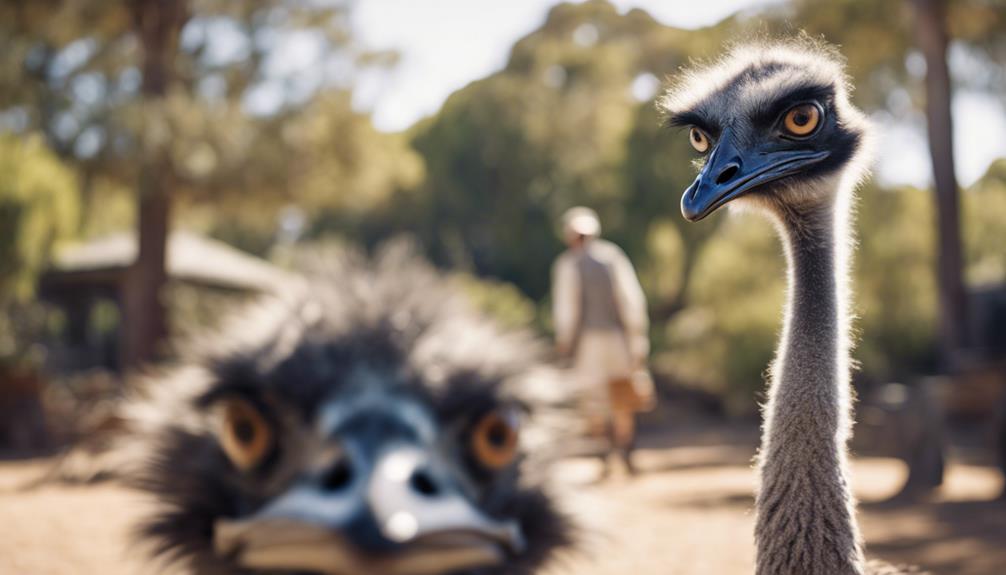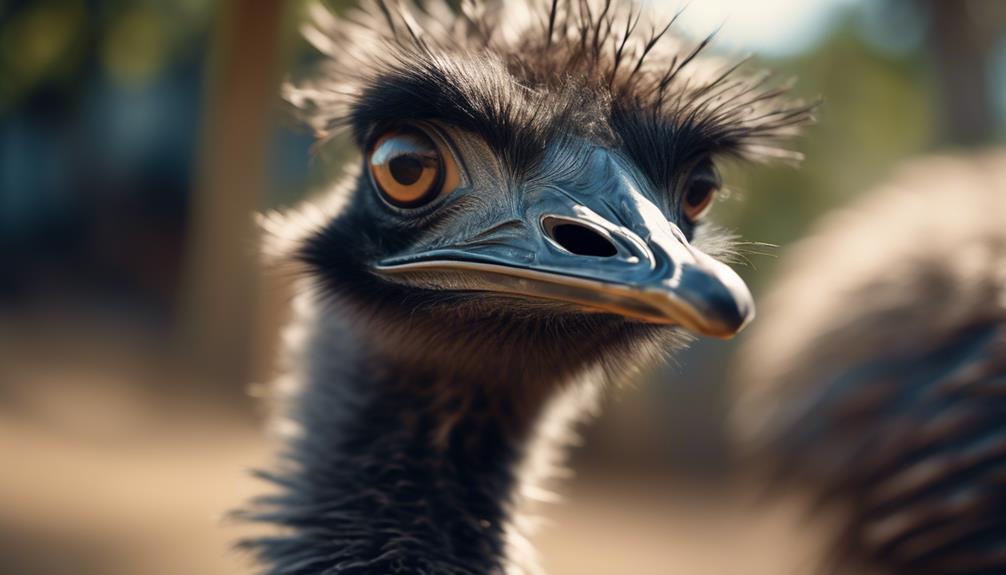
Imagine you are embarking on a journey into the fascinating world of emus, those tall and enigmatic birds that captivate us with their curious behavior. Just like deciphering a cryptic code, understanding what your emu is trying to tell you can be a captivating puzzle.
How do you interpret their vocalizations? What do their body postures reveal? And what about their feeding habits or social interactions? In this discussion, we will unravel the secrets of emu behavior, shedding light on their various gestures and actions, so that you can better understand and communicate with these intriguing creatures.
Get ready to explore the hidden language of emus and unlock the secrets they hold within their feathered frames.
Key Takeaways
- Emus use vocalizations and postures to communicate intentions, emotions, and social interactions.
- Proper feeding and monitoring of physical health are crucial for maintaining emu well-being.
- Emus have a complex social hierarchy and use visual and vocal signals to maintain social cohesion.
- Grooming behaviors are important for emus' emotional well-being and overall health.
Vocalizations and Their Meanings
Emus use a variety of vocalizations to communicate with each other, conveying important information about their intentions, emotions, and social interactions. Interpreting emu calls is crucial for understanding their behavior. Emus have a range of vocalizations, from low grunts and booming sounds to high-pitched calls and hisses. These vocalizations serve different purposes and can be interpreted in various ways.
One common emu vocalization is the booming sound. Male emus produce this deep, resonating call during the breeding season to attract females and establish their dominance. The booming sound can carry over long distances, allowing emus to communicate their presence and territorial claims effectively.
Emus also make high-pitched calls, which are often associated with alarm or distress. These calls are shorter in duration and indicate a potential threat or danger in the environment. When an emu feels threatened, it may emit these calls to alert others and coordinate their response.
Additionally, emus use nonverbal communication through body language to convey their intentions and emotions. They may raise their feathers, puff up their chests, or erect their necks as a display of dominance or aggression. Conversely, a relaxed emu will have lowered feathers and a more relaxed posture.
Understanding emu vocalizations and body language is essential for interpreting their behavior accurately. By paying attention to these cues, you can develop a closer bond with your emu and respond appropriately to their needs and emotions.
Body Language: Understanding Emu Postures
Understanding emu behavior includes being able to interpret their body language, specifically their postures, which can provide valuable insights into their intentions and emotional states. Emus, with their tall stature and unique physical characteristics, have developed a range of postures to communicate various messages. By observing their postures, you can gain a deeper understanding of what your emu is trying to convey.
One common posture is the 'alert' posture, where the emu stands tall with its head held high. This indicates that the emu is aware of its surroundings and is on high alert. On the other hand, a hunched posture with lowered head and wings slightly outstretched may indicate that the emu is feeling threatened or defensive. This posture is often accompanied by hissing or growling sounds.
Emus also use their postures to express dominance or submission. A dominant emu will puff out its chest, raise its neck, and hold its head high, displaying a confident and assertive posture. In contrast, a submissive emu will lower its head and neck, crouch down, and may even lie flat on the ground to demonstrate submission.
Understanding emu postures is essential for effective communication and building a strong bond with these fascinating birds. By paying attention to their body language, you can better understand their needs, emotions, and intentions, leading to a more harmonious relationship.
Feeding Behavior and Its Significance
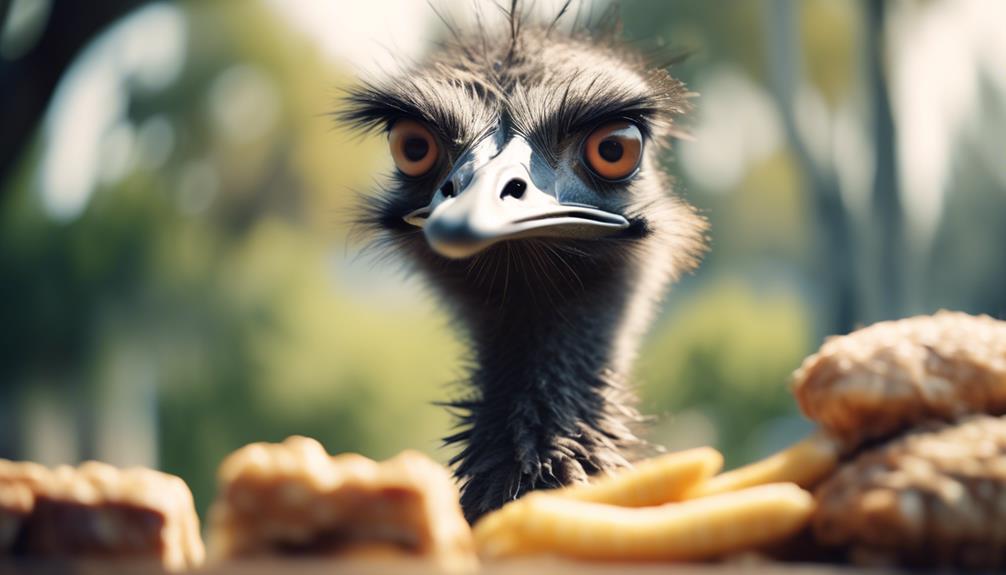
When studying emu behavior, it's crucial to examine their feeding behavior and understand its significance in their daily lives. Emus are omnivorous birds, meaning they eat both plants and small animals. They've a unique foraging pattern that involves pecking and scratching the ground with their sharp beaks. By observing their feeding behavior, you can gain insight into their dietary preferences and nutritional needs.
Emus have a varied diet that includes grasses, seeds, fruits, insects, and small vertebrates like lizards and rodents. They're also known to eat stones and pebbles, which help them grind their food in their muscular gizzard. By understanding their dietary preferences, you can ensure they're provided with a balanced diet in captivity.
The impact of feeding behavior on emu health and well-being can't be underestimated. Emus need a constant supply of food to maintain their energy levels and meet their nutritional requirements. A lack of proper feeding can lead to malnutrition, weakened immune system, and even death. On the other hand, overfeeding can lead to obesity and related health issues. It's important to provide emus with a diet that mimics their natural foraging patterns to ensure their optimal health and well-being.
Social Interactions Among Emus
Social interactions among emus play a crucial role in their daily lives and are fundamental to their overall well-being and survival. Emus exhibit a complex social hierarchy, with dominant individuals occupying the top positions and exerting control over the group dynamics. Understanding the social hierarchy is essential for comprehending their behavior and interactions.
Here are three key aspects of emu social interactions:
- Dominance: Emus establish a clear pecking order within their groups, with dominant individuals enjoying priority access to resources such as food and mates. Dominance is often determined through displays of aggression, such as raising the neck feathers and emitting low-frequency vocalizations.
- Communication: Emus use a variety of visual and vocal signals to communicate with each other. They may engage in head bobs, wing flapping, and hissing to assert dominance or ward off potential threats. Vocalizations, including booming calls and drumming sounds, are also important for maintaining social cohesion within the group.
- Cooperative breeding: Emus engage in cooperative breeding, where multiple adults help raise the young. This cooperative behavior strengthens the bonds within the group and ensures the survival of the offspring. Dominant individuals often take a leading role in protecting and caring for the eggs and chicks.
Understanding the intricacies of emus' social hierarchy and group dynamics provides valuable insights into their behavior and fosters a deeper appreciation for these fascinating birds.
Signs of Distress or Discomfort
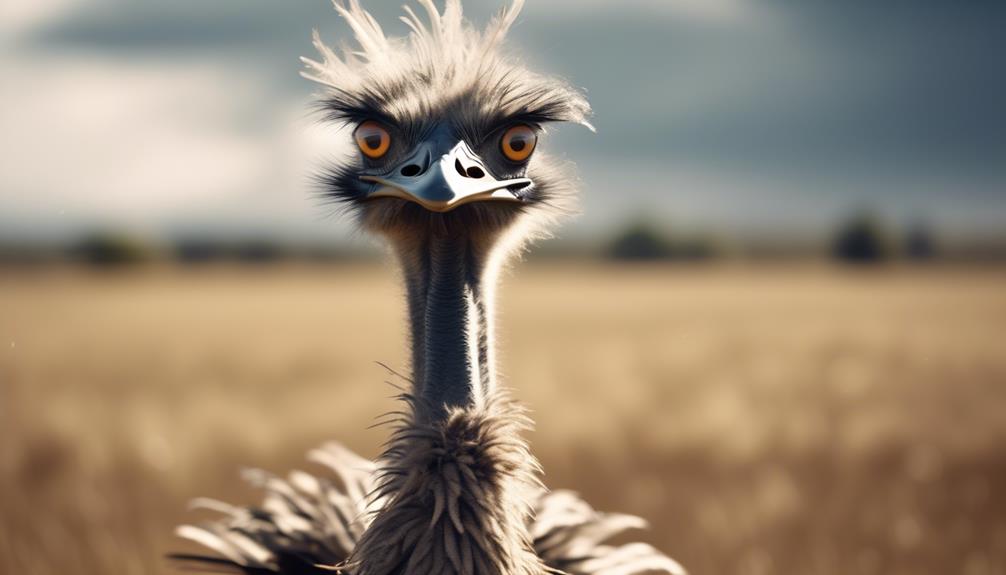
Emus' complex social interactions also provide important cues about their well-being, including signs of distress or discomfort. As an attentive emu owner, it's crucial for you to recognize signs of illness or injury in your bird. Emus, like any other animal, can experience physical health issues that may manifest in various ways. Keep an eye out for changes in their behavior, such as decreased activity, loss of appetite, abnormal feather appearance, or difficulty breathing. These signs could indicate underlying health problems that require prompt attention from a veterinarian.
In addition to physical health concerns, you must also consider the impact of environmental factors on your emu's comfort and well-being. Emus are highly adaptable birds, but certain conditions can still cause distress. Extreme temperatures, inadequate shelter, or poor air quality can all contribute to their discomfort. Ensure that your emu has access to shade, clean water, and a well-ventilated living space. Regularly monitor the temperature and humidity levels in their environment, making adjustments as necessary to maintain optimal conditions.
Emu Courtship and Mating Rituals
Emu courtship and mating rituals involve a series of intricate behaviors and displays that serve to establish and strengthen pair bonds. During the breeding season, which typically occurs from November to March, male emus engage in elaborate courtship displays to attract females.
Here are three key aspects of emu courtship and mating rituals:
- Vocalization: Male emus produce deep booming sounds, akin to a drumbeat, to announce their presence and attract females. These vocalizations can carry over long distances, allowing males to effectively communicate their availability and dominance.
- Dancing: Male emus perform a unique courtship dance to impress females. This dance involves extending their necks, puffing up their feathers, and swaying from side to side. The male also utters soft grunts while bobbing his head and wagging his tail, creating a visually captivating display.
- Nest Building: Once a pair bond forms, the male and female emu work together to prepare a nest for egg-laying. The male selects the nesting site, typically a shallow scrape in the ground, while the female assists by adding leaves, grass, and twigs to create a cozy nest. This collaborative effort helps strengthen the bond between the pair.
Understanding these courtship and mating rituals allows us to appreciate the complexity and beauty of emu behavior during the breeding season. It also provides valuable insights into the reproductive cycles and mating preparations of these fascinating birds.
Territorial Behavior and Aggression
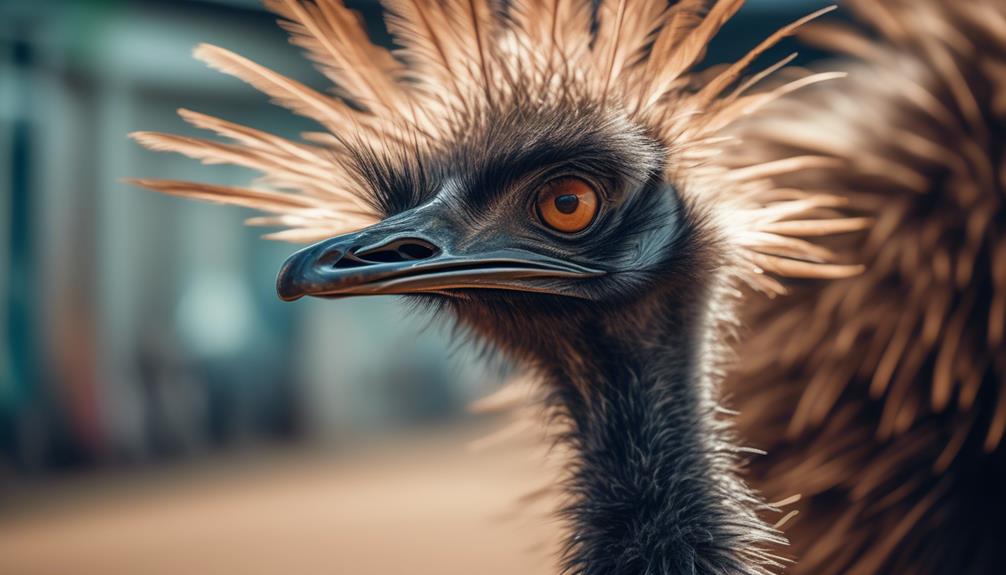
As the breeding season progresses, understanding the territorial behavior and aggression of emus becomes crucial in comprehending the dynamics of their courtship and mating rituals. Emus, like many other bird species, establish dominance hierarchies within their social groups. This hierarchy helps maintain order and reduces conflict during the breeding season. Male emus often engage in aggressive behaviors to establish and defend their territories, which are crucial for successful courtship and mating.
During the breeding season, male emus will vigorously defend their territories from intruders, including other males. This territorial aggression is most pronounced during the nest-building phase, when males are actively seeking out mates and constructing their nests. It is important to note that emus are not inherently aggressive animals, but rather, their territorial behaviors are driven by their instinct to ensure reproductive success.
To better understand the territorial behavior and aggression of emus, let's take a closer look at the dominance hierarchy and nest building process:
| Dominance Hierarchy | Nest Building |
|---|---|
| – Dominant males have access to better resources and are more likely to attract females. | – Males construct nests by scraping out shallow depressions in the ground. |
| – Subordinate males may challenge the dominant males for access to resources and potential mates. | – Nests are typically located in open areas, providing visibility and easy access for females. |
| – Aggressive displays, such as head shaking and hissing, are common during territorial disputes. | – Males use vegetation and other materials to line the nest, creating a comfortable environment for the eggs. |
| – The dominant male's territory is usually larger and better defended than those of subordinate males. | – Nests are often reused in subsequent breeding seasons, with males making necessary repairs and additions. |
| – The dominance hierarchy may change as the breeding season progresses and new challenges arise. | – The success of nest building plays a crucial role in attracting females and ensuring successful reproduction. |
Understanding the territorial behavior and aggression of emus provides valuable insights into their breeding dynamics. By recognizing the importance of dominance hierarchies and nest building behaviors, you can gain a deeper understanding of these fascinating birds and their complex social interactions.
Emu Grooming Habits and Their Importance
Emus demonstrate a meticulous grooming routine that serves important purposes in their overall health and well-being. Understanding the various grooming techniques employed by emus and the benefits of mutual grooming can help you better care for your bird.
Here are some key insights into emu grooming habits:
- Feather Maintenance: Emus use their beaks to gently clean and arrange their feathers. This preening technique helps remove dirt, parasites, and excess oil from their plumage, ensuring optimal insulation and aerodynamics.
- Skin Stimulation: Emus engage in self-scratching by rubbing against trees or other rough surfaces. This behavior not only alleviates any itchiness or discomfort but also promotes blood circulation and the shedding of old skin cells.
- Mutual Grooming: Emus are social birds that engage in mutual grooming with their flock mates. This behavior involves two birds using their beaks to clean each other's feathers. Mutual grooming not only strengthens social bonds but also helps in detecting and removing any parasites that may be difficult to reach alone.
The benefits of mutual grooming extend beyond hygiene. It promotes social cohesion within the flock, reduces stress, and contributes to a sense of overall well-being. Emus rely on these grooming habits to maintain their health and vitality, making it crucial for owners to provide opportunities for appropriate grooming behavior in captivity.
Signs of Contentment and Happiness
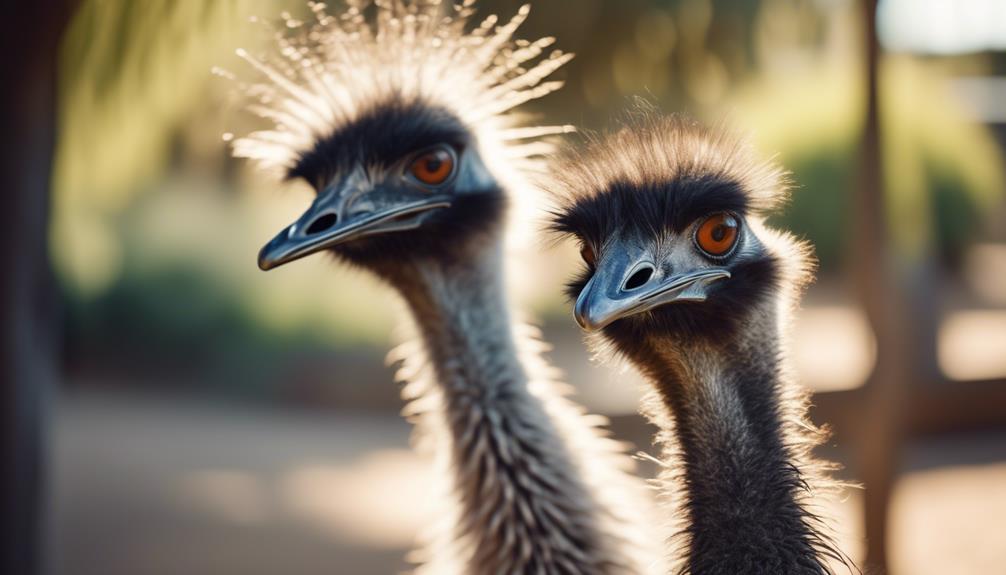
One way to gauge an emu's contentment and happiness is by observing their body language and behavioral responses. By reading their body language, you can identify physical cues that indicate a sense of contentment and happiness in these magnificent birds.
When an emu is content and happy, their body will be relaxed and at ease. Their feathers will appear smooth and well-groomed, indicating good overall health. The emu's head will be held high, with bright and alert eyes. They may also exhibit a slight swaying motion, which is a sign of relaxation and comfort.
Behavioral indicators are also crucial in identifying a happy emu. When an emu is content, they'll engage in playful behavior, such as running and jumping. They may also spread their wings and perform a courtship dance, which shows a sense of joy and fulfillment.
Another sign of contentment and happiness is when an emu displays a calm and friendly demeanor towards humans or other animals. They may approach you with curiosity and allow you to interact with them without any signs of aggression or fear.
Unusual or Abnormal Behaviors to Watch for
Unusual or abnormal behaviors in emus can provide valuable insights into their physical and mental well-being. As an emu owner, it's essential to be vigilant and observant of any signs that deviate from the norm. Here are a few unusual behaviors to watch for:
- Unusual feather patterns: Emus have distinct feather patterns, and any abnormalities in their feathers could indicate underlying health issues. Look out for feathers that are discolored, frayed, or missing. These may be signs of nutritional deficiencies, skin infections, or external parasites. Regularly inspecting your emu's feathers will help you identify any changes and take appropriate action promptly.
- Abnormal eating habits: Emus are known to have hearty appetites, so any significant changes in their eating habits should be taken seriously. If your emu suddenly loses interest in food or exhibits a significant decrease in appetite, it could be a sign of illness or distress. Conversely, excessive eating or a sudden increase in appetite could be indicative of an underlying health issue. Monitor your emu's eating habits closely and consult a veterinarian if you notice any significant changes.
- Unusual vocalizations: Emus communicate through various vocalizations, and any abnormal sounds warrant attention. If your emu starts making unusual or distressed calls, it could be a sign of discomfort, pain, or emotional distress. Pay close attention to their vocalizations and seek professional advice if you notice any concerning changes.
Frequently Asked Questions
What Are Some Common Illnesses or Health Issues That Emus May Experience?
Emus may experience common illnesses or health issues such as respiratory infections, gastrointestinal disorders, and parasites. It is important to monitor their diet and breeding patterns to ensure their overall well-being.
How Can I Introduce a New Emu to a Group Without Causing Conflict?
When introducing a new emu to a group, it's important to follow best practices to minimize conflict. Consider group dynamics and use socialization techniques to help them get acquainted.
Are There Any Specific Plants or Foods That Emus Should Avoid Eating?
Emus have specific dietary restrictions. It's important to be aware of potential toxic plants for emus. Some common ones to avoid include yew, oleander, and rhubarb leaves. Always consult a veterinarian for a comprehensive list.
What Is the Average Lifespan of an Emu in Captivity?
In captivity, emus have an average lifespan of 10-20 years. This can be influenced by various factors such as nutrition, habitat conditions, and veterinary care. Creating a suitable environment is crucial for their longevity.
Do Emus Have Any Natural Predators in the Wild?
Emus do have natural predators in the wild. They are flightless birds, so they rely on their speed and agility to escape from predators such as dingoes and feral cats.
Conclusion
In conclusion, understanding emu behavior is crucial for their well-being and our ability to communicate with them effectively. By deciphering their vocalizations and body language, we can gain insight into their emotions and intentions. Observing their feeding behavior, social interactions, and grooming habits further enhances our understanding.
Additionally, recognizing signs of distress or contentment allows us to respond appropriately. By paying attention to these aspects, we can foster a harmonious relationship with these fascinating birds.
So, dive into the world of emu behavior and unlock the secrets that lie within their captivating actions and gestures.


